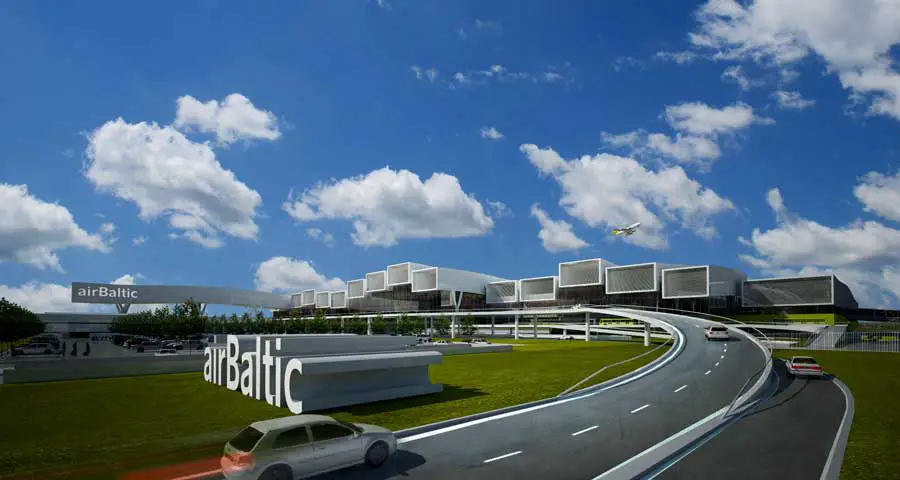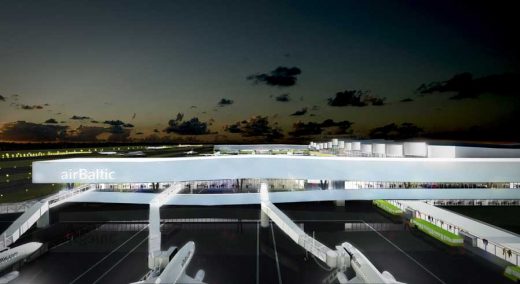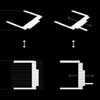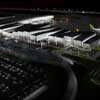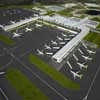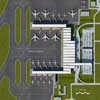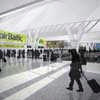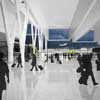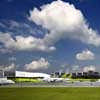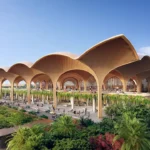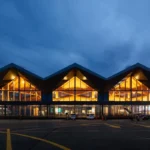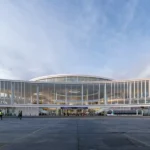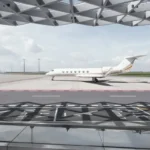AirBaltic Terminal Latvia building competition, Design contest architect, Modern architecture image
AirBaltic Terminal Riga, Latvia
Latvia Architecture Competition – AirBaltic Terminal Riga design contest news.
post updated 17 June 2025
Riga International Airport, Latvia
Design Architect: ZERAFA ARCHITECTURE STUDIO
AirBaltic Passenger Terminal building design:
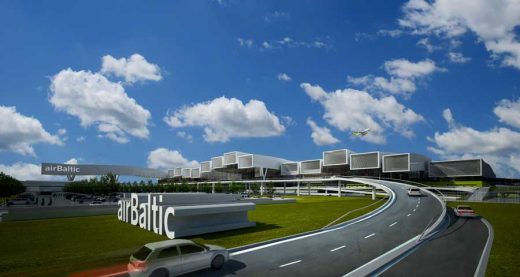
29 Oct 2010
AirBaltic Terminal Riga, Latvia Building Design
INTRODUCTION
The design of the proposed new airBaltic Terminal at Riga International Airport provides us with an exciting opportunity to look critically at the prevailing airport typologies, especially as they relate to a new smaller, single airline terminal of the future.
Over the last 20 years, airport design has focused primarily on creating non-hierarchical spaces contained within or under a single monolithic roof form. Passengers rely almost exclusively on signage and graphics for way-finding as the spaces are disconnected from the primary passenger circulation between airside and landside, the inherent functional requirement of the terminal.
Often terminal design relied on the “interior street” as a concept that was developed as a solution to the large-scale terminal where minimal transfer times and efficient movement between land and airside where not the determining design factor. The scale of these new terminals meant that enormous distances had to be covered by passengers and the relative experience was one that needed to be treated not unlike the retail mall experience.
The passenger circulation in these terminals is not intuitive and encourages meandering, window shopping etc, not unlike circulation within a mall. These spaces tend to emphasize the movement perpendicular to the land to air pathway as in a traditional galleria space. Movement across the barrier becomes secondary and is typically appears as punctuation along this galleria type space.
The unfortunate consequence of this approach is the fragmentation of the personal experience of movement from point of drop off at the curb, through to embarking and departure. Due to external demands of enhanced security and the complexity of passenger circulation and subsequent separation of passenger types, the transition between landside and airside has become increasingly fragmented and confused. Introduction of the Schengen agreement functional requirements has added a new layer of complexity to airport circulation that demands a new approach.
DESIGN CONCEPT
Inherent in the airBaltic brand is the idea of connectivity. This theme is one that is manifest in both the brand profile, and the modern operational culture of the airline. The airBaltic experience is one that seeks to balance the operational necessities of air travel with the more inspirational and positive associations we have with flying.
Freedom is our essential association with flight; however, the experience can suffer under the weight of the operational complexities imposed by contemporary air travel. The exuberance of air travel and the control required by operational considerations may seem mutually exclusive.
The terminal design should address this reality and seek to create an environment where the “control” associated with operations does not effectively extinguish the “freedom” associated with flying. Connectivity and communication are essential components of the solution, and as such, we see the terminal as a conduit for air travel.
The movement of passengers between landside and airside is our point of departure and primary design consideration. This movement from landside to airside can be expressed by a series of parallel virtual corridors defined by the repetition of an extruded form. These “virtual corridors” are created by extruding an inverted u-shaped portal shape in the east/west direction to generate a primary grain clearly describing the landside to airside path.
The building is composed of eighteen parallel portals shapes which are each extruded along a unique curve to create an undulating wave composition running from east to west. The curves are variations on a typical curve generated from the sectional path of passengers travelling from aircraft down to curb and curb to aircraft. The effect is to create a volumetric landscape within the greater airport landscape.
The two portal forms at the north and south ends of the building are each extruded out 224 m beyond the main body of the terminal building to form the Non-Schengen and Schengen departure piers. The volumetric expression of these piers is a clear extension of passenger movement along a landside to airside path. Another portal shape is extruded out to the east towards the city beyond the terminal to provide both a visual link, as well as a physical covered connection from the terminal building to the parking volume.
When viewed from the air, the building form extends a hand into both landside and airside. Conceptually, passenger circulation within the terminal is then either interpreted as with the grain (primary) or against the grain (secondary) creating an experiential circulation hierarchy within the building.
The use of a repetitive module (spatial unit) to make sequence of directional spaces creates a variety of spatial experiences as passengers move throughout the building. Because the extruded portal shapes are moving through space along unique curving trajectories, they create areas of openness and compression as they rise up or move downward towards the floor.
The effect is to reduce the scale of the interior volumes by defining a series of varied interior compartments. This familiar rhythm of directional spaces recalls the composition of barreled vault buildings of the Riga landmark Central Market, themselves with a historical connection to flight. This use of this type of repetitive unit also facilitates the future bay by bay expansion of the terminal.
As transfer passengers make up approx 70% of the projected passenger capacity, the quality of the transfer passenger experience and efficiency of transfer circulation is critical to airBaltic customers. In contrast to typical terminal profiles, the relative importance of the transfer passenger suggests that the movement of these passengers should inform the building design in a direct and meaningful way.
The internal network of transfer passenger circulation from gate to gate through the required security and passport controls is consolidated into an L-shaped object to create a distinct airBaltic “Transfer Bar” that is expressed in the terminal massing as a colored floating volume. Identified by the airBaltic green, the transfer bar volume is legible at distance to arriving passengers prior to arrival at the contact gates or transfer from remote gates.
Passengers can visually identify their unique transfer circulation path and destination before entering the terminal. This provides passengers with clear and intuitive way-finding within the building immediately upon arrival.
VEHICULAR CIRCULATION- SITE ACCESS
The Departure Hall is located at ELEV +8m. Access roadways to the north ramp up from the typical street elevation to provide all vehicular drop-off for departures at this level. The departures drop-off area contains two 3-lane roadways separated by a central pedestrian platform. This allows for the effective separation of taxis, private cars and buses at curbside.
The curbside roadway provides two taxi drop-off lanes and by-pass lanes. The outer roadway provides for bus parking/waiting, private vehicle drop-off, a by-pass lane and direct access to the parking structure at parking level 3 for private vehicle parking and car rental return. Only entry to the structured parking is permitted at this level, all exits are located at grade and within the Arrivals area.
The Arrivals Hall is located at grade ELEV 0m. Access roadways to the north divert to provide all vehicular access for Arrivals. The Arrivals drop-off area contains two 3-lane roadways separated by a central pedestrian platform. This allows for the effective separation of taxis, private cars and buses at curbside pick-up.
The curbside roadway provides two taxi queuing lanes for passenger pickup and a by-pass lane. The outer roadway provides for bus parking/waiting, private vehicle passenger pickup, a by-pass lane and direct access to and from the parking structure and surface lot for private vehicle parking and rental car return.
Typical long-term and short-term parking for private vehicles is located within a 4-level structure adjacent to the terminal. The parking structure provides approx 1450 spaces within 3.5 levels. The North Surface Lot located adjacent to the structure provides an additional 350 spaces at grade.
The planned reduction to 1200 spaces would eliminate the 3rd and 4th floors of the current structure. Pedestrian access from the terminal building to the parking structure is provided underneath one of the portal forms that extend out to the east from the terminal to. Connection can be made at grade within the Arrivals area, and by sky-bridge from the Departures level.
A Service roadway with a secure entry is located off the north/south service road to the north of the Surface Lot. This 2-way roadway tunnels under the arrivals roadway to provide direct truck access to the covered loading dock area located at ELEV -1m for all landside terminal deliveries, general airport service, trash pickup and recycling.
DEPARTURES HALL
The terminal interior is organized on a 20m module, defined by the typical portal roof forms extruded from east to west. Interior volumes containing the program areas including office space, food, beverage and retail concessions, passenger lounges and other services form the landside-airside barrier within the terminal.
These volumes are projected into both the landside and airside of the departures volume to create a 3-dimensional matrix of distinct 5m tall objects or voids that can be easily distinguished to clarify use, and facilitate intuitive circulation within the terminal. This dynamic composition of projecting volumes permits specific program elements such as the airBaltic premium lounges to penetrate the landside-airside barrier to occupy both spaces.
Departing passengers enter the Departures Hall from curbside in three distinct locations across interior entry bridges. Within the airside Departures Hall, 19 check-in counters and bag drops for all flights are grouped together within three 20 m bays to the south end to maximize the effective drop-off length and visibility from the curb. Premium counters are grouped together in one bay. Self check-in kiosks are located opposite the check-in area to facilitate direct access to bag-drop counters.
The central entry point for boarding-pass control and airport security for both Schengen and Non-Schengen departures is located within two 20m bays at the north end of the Departures Hall and creates a large controlled void in the landside-airside barrier. This area is separated from the check-in area by volumes containing both retail shops and airline related offices.
Food and beverage concessions are located at the south end of the hall with views to the south garden at ELEV. 0m. This layout allows for primary circulation for departing passengers within the departures hall to be clear and efficient.
Immediately after passing through outbound security, departing passengers for Schengen flights are free to move throughout the main Airside Concourse and departure pier located to the south. Retail, food and beverage concessions, passenger services and airBaltic premium lounges are located within this main concourse and within the departure pier adjacent to the gate and hold areas.
The South Pier contains 9 dedicated contact departure gates for Schengen flights as well as a bi-level holdroom for passengers departing by shuttle to the 15 remote gates.
After passing through outbound security, passengers for Non-Schengen flights must then pass through Passport Control/Immigration to enter the Non-Schengen Concourse and departure pier to the north. Retail, food and beverage concessions and passenger services are located within this main concourse and within the departure pier adjacent to the gate and hold areas.
The North Pier contains 8 dedicated contact departure gates for Non-Schengen flights including 2 enclosed holdrooms for USA bound flights as well as a bi-level holdroom for passengers departing by shuttle to the 8 remote gates.
Both piers contain an elevated “Runway Lounge” accessed by ramp that is open to all departing passengers. The lounge is located within the open glazed western end of the portal form and features a 20m/25m x 10m window wall overlooking the runway to the west.
ARRIVALS HALL
The Arrivals Hall and Baggage Claim area is located at ELEV. 0m directly below the Departures Hall. The Baggage claim areas for Schengen and Non-Schengen flights are located at the south and north ends of the hall respectively, and are separated by a central Customs center through which all exiting passengers must pass before exiting into the Arrivals Hall and curbside pickup areas.
There are 3 Code C claim belts within the Schengen Baggage Claim area and 2 Code D/E claim belts within the Non-Schengen Baggage Claim Area. A communicating stair is located within the Arrivals Hall at the north end of the terminal to provide a link to the Departures Hall above. As all arriving passengers enter the Arrivals Hall at the ends and work their way towards the center through a common Customs to exit, circulation is clear and efficient for destination passengers.
DESTINATION PASSENGER CIRCULATION
Passengers arriving from Schengen flights with Riga International Airport (RIX) as their final destination must first disembark at the South Pier contact or remote gates and then descend down to the Schengen Arrival Baggage Claim area located at the south end of the terminal at ELEV. 0m. After collecting baggage, all arriving passengers must pass through this central Customs Center to exit the Terminal and access the curbside pickup areas or Parking.
Passengers arriving from Non-Schengen flights with Riga International Airport (RIX) as their final destination must first disembark at the North Pier contact or remote gates and then descend down to one level below at ELEV. 4m and pass through Immigration/Passport Control to access the Non-Schengen Arrival Baggage Claim area located at the north end of the terminal at ELEV. 0m. After collecting baggage, arriving passengers must pass through Customs to exit the Terminal and access the curbside pickup areas or Parking.
Car rental offices and pickup is located within the first level of the structured parking.
TRANSFER PASSENGER CIRCULATION
airBaltic transfer passengers can be grouped into 4 distinct groups with specific circulation and procedural requirements based on the Schengen Agreement. The airbaltic “Transfer Bar” was developed to provide transfer passengers with an intuitive and identifiable transfer route and facilitate the efficient movement of significant numbers of transfers through the terminal to minimize connection times.
Passengers arriving from Schengen flights and transferring to other Schengen flights can disembark at the South Pier and transfer freely between contact gates or the remote gate holdroom without passing through security or Immigration.
Passengers arriving from Schengen flights and transferring to Non- Schengen flights must first disembark at the South Pier contact or remote gates and then enter the airBaltic “Transfer Bar” one level below, pass through Immigration/Passport Control to enter the North Pier departure contact gates or remote gate holdrooms.
Passengers arriving from Non- Schengen flights and transferring to Schengen flights must first disembark at the North Pier contact or remote gates and then directly enter the airBaltic “Transfer Bar” one level below, pass through Immigration/Passport Control and Airport Security to enter the Schengen concourse, South Pier departure contact gates or remote gate holdrooms.
Passengers arriving from Non- Schengen flights and transferring to other Non-Schengen flights must first disembark at the North Pier contact or remote gates and then enter the airBaltic “Transfer Bar” one level below, pass through Airport Security, then Immigration/Passport Control to re-enter the Non-Schengen concourse, North Pier departure contact gates or remote gate holdrooms.
STRUCTURAL CONCEPT
The terminal building utilizes a 20 m x 20m typical structural module.
The proposed terminal roof is composed of eighteen parallel portal shapes that are each extruded along a unique curve to create an undulating wave composition running from east to west. The two end modules at the north and south edges of the building extend west beyond the main terminal envelope to create the terminal piers supporting the contact gates for Non-Schengen and Schengen flights respectively.
The typical extruded portal, an inverted 10m deep U-shaped form of uniform dimension, is composed of an integrated steel trussed-tube that follows the undulating geometry specific to each 20m wide module. The truss within each module is connected laterally to the adjacent truss within the 2m glazed gap that extends the length of the U-shaped form with a series of horizontal steel connectors.
Y-shaped vertical supports are located on a 40m x 40m module to carry loads from pairs of the trussed tubes to the ground.
The contact gate piers contain a horizontal transfer truss within the transfer level to allow the typical trussed-tube support columns to move inward toward the center of the pier to minimize the structural footprint within the apron areas.
AirBaltic Terminal Riga – Building Information
Design Team: Jason Zerafa, Joaquin Boldrini, Katherine Moya
Client: AirBaltic
Facility: Passenger Terminal
Location: Riga, Latvia
Size: 60,000 sqm
Status: Shortlisted International Competition Proposal, 2010
Images by: ZERAFA ARCHITECTURE STUDIO
Location: Riga, Republic of Latvia, eastern Europe.
New Architecture in Latvia
Contemporary Latvian Architecture
Riga Architecture Designs – chronological list
Riga Architecture Designs – chronological list
Latvian Architecture – Selection
Ropax Terminal Riga, Latvia building
Design: Zaha Hadid Architects
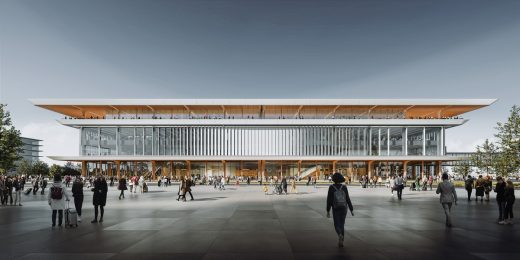
render : Negativ
Latvian Museum of Contemporary Art, Riga, central Latvia
Rem Koolhaas / OMA
Latvian Museum of Contemporary Art
Riga Urban Centre
Fletcher Priest
Riga Masterplan : Design Competition win
Villa Pinia, Jurmala
Ark-house Architects
Villa Pinia
Latvia Building – Architecture Competition
Gunnar Birkerts Latvian architect of Museum of Occupation, Riga
Comments / photos for the AirBaltic Passenger Terminal Riga – Latvian Architecture Competition page welcome

